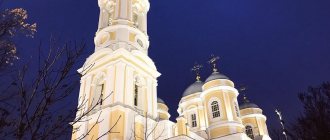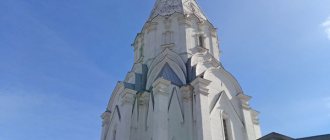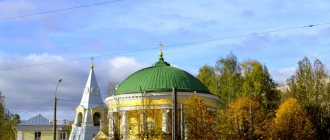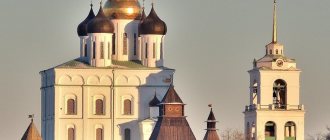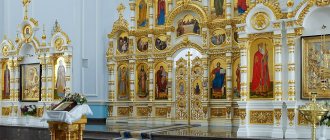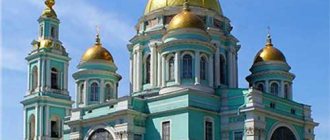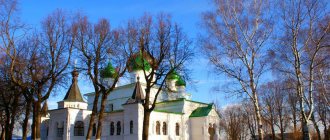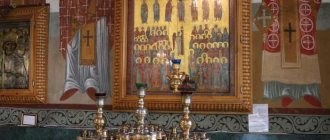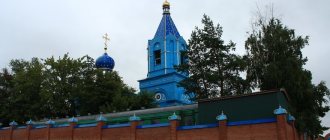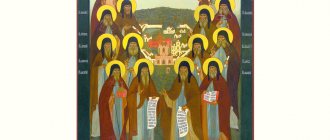One of the attractions of Tsarskoe Selo (city of Pushkin, St. Petersburg) is Fedorovsky Town, a complex of buildings in the pseudo-Russian style in Fermsky Park, not far from Alexander Park and the Palace . The main dominant feature here is Feodorovsky Cathedral , or, as it was called before the revolution, Feodorovsky Sovereign Cathedral . Currently, it belongs to the St. Petersburg diocese of the Russian Orthodox Church and belongs to the Tsarskoye Selo deanery district. The rector is Bishop Markell (Vetrov).
♦ On topic: A selection of excursions around St. Petersburg, palace suburbs and the Leningrad region
Feodorovsky Cathedral in Tsarskoe Selo. View from Alexander Park
Construction and consecration of Fedorovsky Cathedral
Initially, Fedorovsky Cathedral was conceived as a church for His Majesty's Own convoy and the Consolidated Infantry Regiment. Emperor Nicholas II personally indicated the location for the temple. On August 20 (September 2), 1909, the solemn foundation ceremony of the temple took place; the emperor personally laid the first stone in the foundation of the future building.
Procession of the Cross on June 24, 1910. Photo from the collection of M.Yu. Meshchaninov
The development of the project was entrusted to the architect A.N. Pomerantsev (1849-1918). However, already at the stage of construction of the foundation, it was criticized, because the cathedral looked too large and heavy. They invited the architect V.A. Pokrovsky (1871-1931), who proposed another project, where the Annunciation Cathedral of the Moscow Kremlin was taken as the basis. Also, the architect V.N. Maksimov (1882-1942), a follower and assistant of V.A. Pokrovsky and A.V. Shchusev (1873-1949), took part in the work on creating the temple. The new project was approved on August 1 (14), 1910.
In total, 1 million 150 thousand rubles were spent on the construction of the temple, of which 150 thousand rubles were donated by Emperor Nicholas II and Empress Alexandra Fedorovna. The remaining amount was collected through voluntary donations from industrialists and merchants.
On August 20 (September 2), 1912, the temple was solemnly consecrated by Protopresbyter of the military and naval clergy Georgy Shavelsky (1871-1951). The Emperor and his family were present at the consecration. On January 26 (February 6), 1914, the church was renamed the Feodorovsky Sovereign Cathedral - in honor of the ancient copy of the Feodorovskaya Icon of the Mother of God , in whose name the main altar was consecrated.
Reception of delegations by the Sovereign Emperor after the consecration of the church, August 20, 1912. Photo from the collection of M.Yu. Meshchaninov
Feodorovsky Cathedral was the “parish of the emperor’s family.” Here he attended Sunday and holiday services. Ordinary people could only get here with special invitation cards, which had to be obtained from the palace commandant. After the abdication of the emperor, Fedorovsky Cathedral became a parish church.
Theodore Sovereign's Cathedral. Pre-revolutionary photography
Structure and interior decoration of Fedorovsky Cathedral
Fedorovsky Cathedral is made in the traditional style: four-pillar, cross-domed. It consists of two temples - upper and lower. The upper temple is large and bright, can accommodate up to 1000 people praying. The high iconostasis is made in the style of churches of the 17th century. The main altar was consecrated in the name of the Feodorovskaya Icon of the Mother of God , the side chapel - in the name of St. Alexis, Metropolitan of Moscow (they did not manage to consecrate it before the 1917 revolution).
Iconostasis. Photo of 1912 from the collection of M.Yu. Meshchaninov
The Lower Church , or Cave Temple, was consecrated in the name of St. Seraphim of Sarov . The throne was moved here from a temporary temple built in 1909. There is also an ark with particles of the relics of St. Seraphim of Sarov. It was consecrated on November 27 (December 10), 1912. The emperor usually prayed here during fasting. Pay attention to the clothes of the soldiers - they are made according to Vasnetsov’s drawings.
Lower Temple. Photo of 1912 from the collection of M.Yu. Meshchaninov
Around the Feodorovsky Cathedral, on a large foundation left over from Pomerantsev's project, porches, chapels, a sacristy, etc. were built. The main entrance is decorated with a large mosaic panel depicting the Feodorovskaya Icon of the Mother of God. A red granite staircase leads to the temple.
The area in front of the southern facade was considered the front area. Members of the royal family planted seven oak trees here. During the occupation of Tsarskoye Selo during the Great Patriotic War, three of them were cut down, and four oaks have survived to this day. A monument to Emperor Nicholas II is also erected here.
Feodorovsky Cathedral in Tsarskoe Selo
Feodorovskaya Church
st. Green Embankment, 7a
Feodorovskaya Church. 2015
Theodore Church occupies a special place in the history of Vyatka. This was the last temple built in the pre-revolutionary city. Its construction is closely connected with the large-scale celebrations that took place in 1913 throughout Russia in honor of the 300th anniversary of the Romanov family, which is why the church was also called “Romanovskaya”.
The history of the temple began with an anonymous letter in which an unidentified person informed Bishop Nikandr of Vyatka and Slobodsky about the desire of the residents of the northern part of Vyatka to build a temple. The newspaper “Vyatka Rech” on the day of laying the foundation of the new church reported that “Reverend Nikander, upon his arrival at the Vyatka See, paid serious attention to the absence of parish churches in the northern and southern parts of the city of Vyatka. The City Duma, at the request of the Vyatka bishop, gave up space in the northern and southern parts of the city for the construction of churches, and construction began first in the southern part of the city. Rev. Nikandr made the first contribution to this holy cause, allocating a thousand rubles from his personal funds.”
.
Feodorovskaya Church. Beginning of the 20th century
After this, in 1914, a committee for the construction of the temple was created, it included P. N. Shklyaev (chairman), O. A. Tanaevsky (fellow chairman), committee members I. A. Charushin, A. A. Istomin, A. V. Rumyantsev, P. A. Shilnikov, F. A. Ezdakov, V. M. Khlebnikov and others. “Vyatka Diocesan Gazette” wrote on June 18, 1915 that “a new temple is being built in memory of the 300th anniversary of the House of Romanov. The place for it was chosen very well. Situated on a very high bank of the river. Vyatka (near the prison companies), it will be visible for ten miles around. At the same time, it will satisfy the long-overdue need for a church on the northern outskirts of the city of Vyatka, which has previously been deprived of a church.”
. In 1915, the lower church was consecrated in honor of the all-Russian shrine - the Feodorovskaya Icon of the Mother of God, the patroness of the Russian state and the Royal House of Romanov. The top floor is in the name of St. Nicholas. The parish of the church at that time consisted of 30 people aged from 40 to 60 years.
View of the Feodorovskaya (Romanovskaya) Church. Early 1960s
I. A. Charushin was chosen as the architect of the temple. If in the project of the Seraphim Church the author drew inspiration from the appearance of the churches of Moscow in the 17th century, then in the appearance of the Feodorovskaya Church the influence of Novgorod and Pskov temple architecture is noticeable. We can list only a few characteristic details: the austere appearance of the building - sparseness in decoration, gabled pediments, the Pskov belfry - instead of a bell tower. It is interesting that Charushin did not abandon multi-domes this time, only the decorative domes received a different form - not onions (as in the appearance of the St. Seraphim Church), but “tongues of flame.” The temple, small in volume, looks tall, reaching into the sky.
Feodorovskaya Church. 1958
In 1929 the temple was closed, they decided to convert it into a textile workers' club, and in 1930 into a Stroyuch hostel. It is interesting that the last project was carried out by the same architect I. A. Charushin. There is a version that in this way he wanted to save the temple from destruction. On the lower floor, 6 living spaces, 2 storage rooms, a washroom, etc. were designed; on the top floor there are 5 living rooms, a “red corner”, two storage rooms, a storage room, a washroom and a guard room. Thus, for many years the church was forced to “forget” about its purpose.
During the Great Patriotic War, the church building housed a collection point; it became a military facility and was surrounded by barbed wire. In fact, during this period, Kirov soldiers went straight to the front from the former Feodorovskaya Church. Former investigator of the military prosecutor's office Tamara Sergeevna Naumova, in an interview with historian M. S. Solovyova, recalled this time as follows:
“In Kirov, regiments were formed from teams that arrived from Borovoe, Vishkil, Slobodskoye, etc. In winter, the famous ski battalions were formed from them. The teams arrived at the church, where they were uniformed, equipped, and the company prepared for departure. The marching companies followed to Kirov-Kotlassky, lined up on the parade ground and went to the front... I, as an investigator of the military prosecutor's office, had to visit this church more than once (there were cases of self-harm). Since it was a military facility, it was surrounded with barbed wire and sentries were posted. On the ground floor of the church there was a high living space, along the perimeter of which there were bunks in 4 tiers. There was a deep basement where military warehouses (uniforms, equipment, food) were located. The church is a distribution company of the 34th Infantry Division, through which 252,353 people passed. New reinforcements were coming to the front in a continuous stream, which poured like blood into the weakened units of the active army.”
.
Plan for the conversion of the Feodorovskaya Church by I. A. Charushin into a Stroyuch hostel
In 1946, the building was returned to the Russian Orthodox Church, and services were resumed there. The post-war year was very hungry; eyewitnesses recalled a huge number of coffins; the dead were brought to church every hour for funeral services. In the early 1960s. The city was expecting the arrival of N.S. Khrushchev, while at the same time a new round of anti-religious campaign was underway in the USSR. In 1958 – 1961 Twenty churches were closed in the Kirov region. Khrushchev ultimately never came to Kirov, but as a result of the excessive “zeal” of the city authorities, in October 1962 the temple was closed again and doomed to destruction. Residents of Kirov who lived in neighboring houses recalled that neither the first nor the second explosion succeeded in destroying the church. Later, they were able to blow up the bell tower, then the tanks got to work: they pulled the cables tied to the protruding parts of the structure, and eventually destroyed the temple. The church building stood in this dilapidated state for some time until it was gradually dismantled. The roadway on Rosa Luxemburg Street was paved with fragments of the temple stones.
Feodorovskaya (Romanovskaya) Church. 1955 – 1960
In 1974, the city authorities tried to erect a monument on this holy place in honor of the 600th anniversary of the city of Kirov; the so-called foundation was laid at the foundation of the temple. time capsule. It contained about 30 exhibits, mainly products from enterprises in the Kirov region: dolls, accordions, tires, fur coats, etc. Also in the capsule were busts of Lenin and Kirov, the first issue was a message to the future generation from the pioneers of the past. What these children of the 1970s wished for their descendants remains a mystery to this day. After the capsule was laid, this place on the embankment was a wasteland for more than 30 years.
Destruction of Theodore Church. 1962
In 2002, the city administration allowed the Vyatka diocese to begin work on the restoration of the Feodorovskaya Church. At the design stage, it became clear that the embankment would not support the heavy stone building - landslides would begin. It was decided to abandon the original plan to restore the church according to Charushin’s design. In 2006, the Vyatka diocese proposed to build a small wooden church on this site - a copy of the Vladimir Church at the residence of the President of the Russian Federation in Valdai, which was done. On August 25, 2007, the new Feodorovsky Church was consecrated.
Photo: herzenlib.ru, GAKO, pastvu.com

